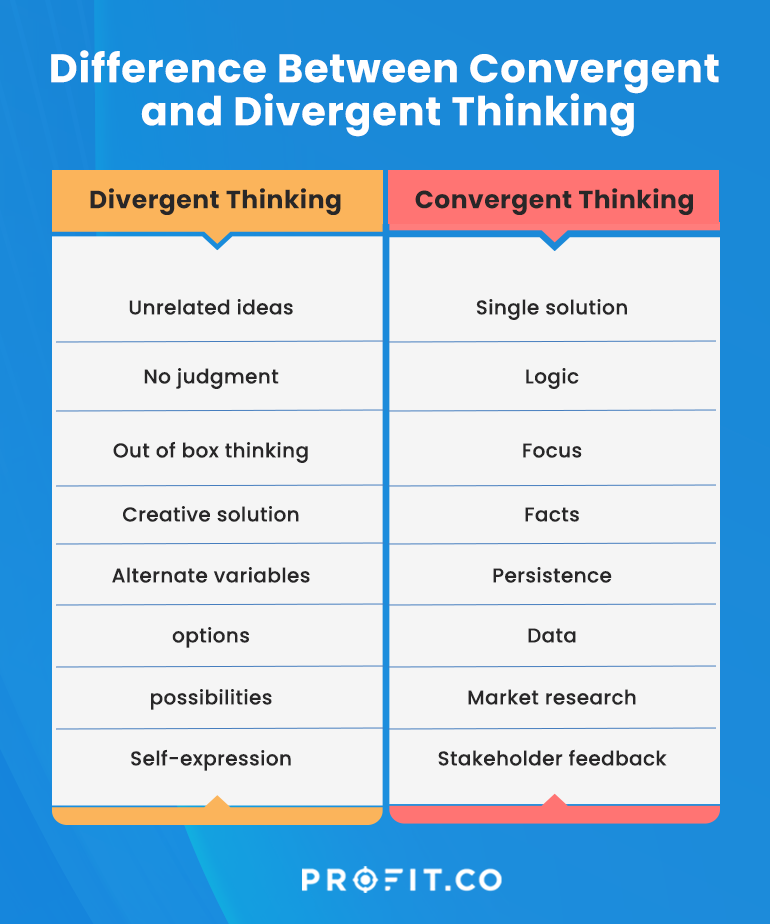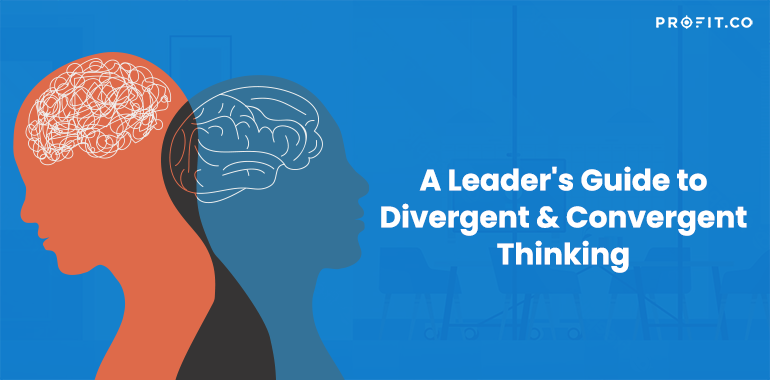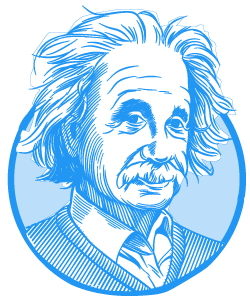Effective leadership hinges on the ability to navigate complex decision-making landscapes. Leaders must foster a culture of innovation while ensuring efficient and well-considered choices. This requires mastery of two distinct yet complementary thought processes: divergent and convergent thinking.
Understanding Divergent and Convergent Thinking
Divergent Thinking
This is the brainstorming phase, where all ideas are welcome, no matter how outlandish they might seem. It’s about quantity over quality, widening the net as far as possible to capture diverse solutions and perspectives. In practical terms, divergent thinking might involve team brainstorming sessions, mind mapping, solo ideation, or creative workshops. It’s particularly useful in the initial stages of problem-solving when you want to explore every possible avenue.
- The collision of diverse perspectives can lead to the generation of novel and groundbreaking ideas that have yet to emerge through traditional approaches.
- Individuals who may not typically be vocal contributors can offer invaluable insights when encouraged to participate in a free-flowing, judgment-free environment.
“Creativity is seeing what others see and thinking what no one else ever thought.”
Convergent Thinking
After the storm of ideas generated by divergent thinking, convergent thinking helps to narrow down these options to the most viable ones. It involves critical thinking, decision-making, and assessing the feasibility of ideas against the criteria of the project or problem at hand. It’s about quality over quantity, refining and focusing on the solutions most likely to succeed according to the given constraints and goals.
- A clear path forward is established by minimizing ambiguity and ensuring efficient resource allocation.
- Focused discussions and streamlined decision-making processes prevent analysis paralysis and allow teams to direct their collective energy toward execution.
To learn more about achieving continuous learning for your organization.
The Dance Between Divergence and Convergence
A skilled leader knows when to open the floor to a wide array of ideas and when to start honing in on the specifics. Leaders must be adept at nurturing a vibrant environment of creative exploration while possessing the discipline to select the most promising ideas and translate them into actionable strategies.
Here’s how you can master this balance in 6 Easy Steps
- Make it clear when the goal is to generate ideas (divergent) and when the focus shifts to narrowing those ideas down (convergent). This clarity helps team members understand the expectations and how they can contribute effectively at each stage.
- Foster an environment where all team members feel comfortable sharing their thoughts. The phrase “no idea is a bad idea” can be helpful here. A critical first step involves questioning existing paradigms and encouraging inquiry through “why” and “what if” scenarios. Techniques like mind mapping, time-boxed idea generation, anonymous contributions, online collaboration tools, or random word prompts stimulate creative thinking.
- When shifting to convergent thinking, tools like SWOT analysis (strengths, weaknesses, opportunities, and threats), prioritization matrices, or even simple pros and cons lists can help evaluate the ideas. Integrate relevant data, market research, and stakeholder feedback to inform decision-making. Encourage analytical thinking and critical evaluation in this phase.
- Promote the use of lateral thinking to bridge divergent and convergent thinking. This can involve challenging assumptions, looking for unusual connections, or combining different ideas in novel ways to create innovative solutions. Cultivate a culture that encourages the exploration of diverse possibilities without prematurely dismissing ideas as impractical.
- Be mindful of how you transition between thinking modes. You can signal shifts by changing the setting, rearranging teams, or taking breaks between sessions. This helps to reset the team’s mental models and prepares them for the next phase of thought. Leaders should remain flexible and avoid becoming overly attached to specific ideas, allowing for revisions based on emerging insights.
- Show your team how you value both creative and critical thinking. Demonstrate how you entertain wild ideas without judgment and later switch gears to evaluate them critically. Your behavior sets the tone for the team’s approach.
By mastering divergent and convergent thinking, leaders equip themselves to navigate the complexities of decision-making and propel their teams toward achieving exceptional results.

How do leaders translate this theory into a practical problem-solving process?
Divergent and convergent thinking are essential, but their true power lies in a leader’s ability to weave them together seamlessly. The magic happens when you can encourage expansive thinking and harness this creativity into actionable, strategically sound plans. Like any skill, this requires practice and awareness. Still, with deliberate application, you can significantly enhance your leadership effectiveness and lead your team through the complexities of the modern business environment.
1. Frame the challenge & set the stage
Clearly define the problem you’re tackling. Is it a new product launch, a process improvement, or a marketing campaign? Next, establish the ground rules for divergent thinking. Emphasize that all ideas are welcome. Employ techniques like “round robin” brainstorming, where everyone contributes an idea before moving on. Consider anonymous contributions through online tools or physical suggestion boxes to remove inhibitions. Inject a dose of “lateral thinking” by encouraging connections between seemingly unrelated ideas. Challenge assumptions and prompt the team to look at the problem differently.
2. Capture and document the divergent ideas
Meticulously document all ideas on a whiteboard, digital collaboration tool, or sticky notes. Encourage active listening and capture even seemingly outlandish ideas. Once the brainstorming session concludes, group similar ideas together. This helps identify patterns and potential areas for combining concepts. As a leader, use your judgment to prioritize a manageable number of ideas for further discussion. Consider factors like feasibility, potential impact, and alignment with overall goals.
3. Convergent thinking takes center stage
Guide the team through a structured evaluation using tools like SWOT analysis or a weighted scoring system. Incorporate relevant data, market research, and stakeholder feedback to inform decision-making. This provides a reality check for the initial ideas. Encourage healthy debate and critical analysis of each shortlisted idea. Ask probing questions to identify potential weaknesses and ensure solutions are well-rounded. Lateral thinking can bridge the gap between divergent and convergent approaches. This involves challenging assumptions, finding unusual connections between seemingly disparate ideas, and combining them for novel solutions. Remember, transitioning between divergent and convergent thinking requires intentionality. Consider breaks, location changes, or team reshuffles to signal a shift in focus. Leaders are crucial in maintaining flexibility and avoiding attachment to specific ideas, allowing for revisions as new information surfaces.
4. Refine, decide & take action
Selecting the best course of action based on the convergent evaluation is the final step. Based on the evaluation and discussions, lead the team in identifying the solution that best addresses the problem. Be open to refining the chosen approach based on emerging insights. Consider potential risks and mitigation strategies for the chosen course of action.
Final Thoughts
Ready to improve your problem-solving skills? Try these steps with your team. You might be surprised at the innovative solutions that emerge when you harness the power of divergent and convergent thinking. By encouraging a systematic approach to problem-solving that includes embracing diverse perspectives and rigorously evaluating them, leaders enhance their effectiveness and drive their organizations toward sustained growth and innovation.
Learn more about achieving continuous learning for your organization with Profit.co today
Related Articles
-
Status Quo Bias in the Workplace
Is your organization unknowingly sabotaging its own progress? The Status Quo Bias, a subtle yet powerful human tendency, often keeps... Read more
-
Why Communication Styles Matter More Than You Think
Effective communication is the bedrock of organizational success. As a leader, how you listen, speak, and respond profoundly shapes productivity,... Read more
-
How to Drive Engagement & Growth Through Servant Leadership
Tired of battling the constant drain of employee disengagement? The revolving door of turnover isn't just frustrating; it costs your... Read more
-
The Gentle Push: How Smart AI Nudges Boost Team Productivity
Today, simply measuring employee sentiment is no longer enough. The C-suite isn't interested in yet another dashboard or report. They... Read more

